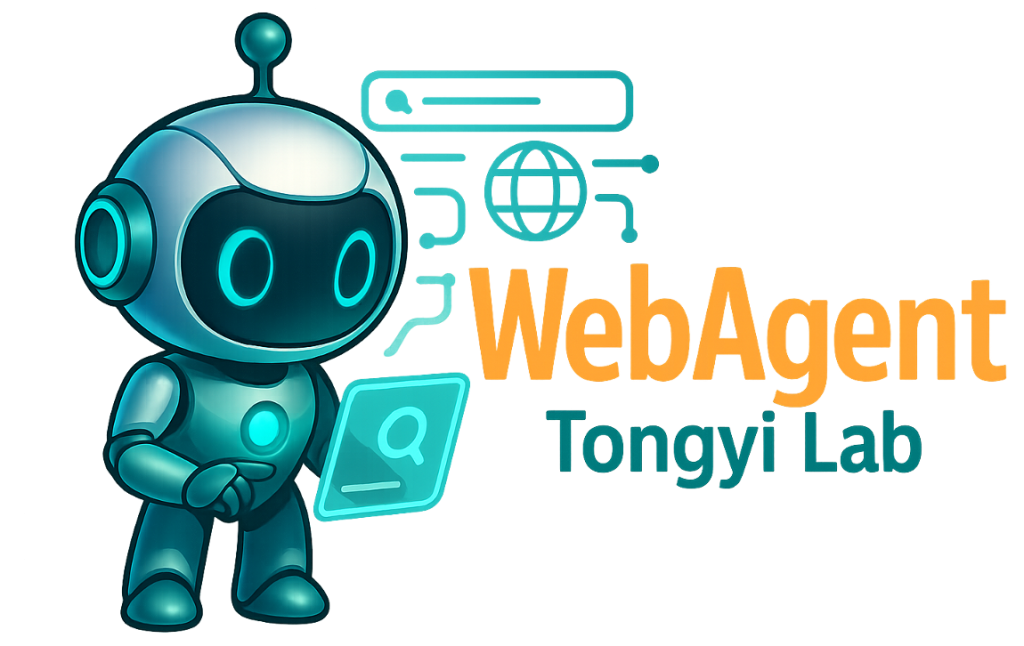WebDancer: Breakthroughs in Autonomous Information-Seeking Agents

WebAgent for Information Seeking bulit by Tongyi Lab, Alibaba Group
Introduction: A New Paradigm for Complex Problem-Solving
Traditional AI systems often struggle with complex real-world problems due to shallow, single-step information retrieval. Yet humans solve intricate tasks through multi-step reasoning and deep exploration—like researchers cross-referencing studies or validating hypotheses. Alibaba’s Tongyi Lab now addresses this gap with WebDancer, an open-source framework for training end-to-end autonomous information-seeking agents that browse the web and reason like humans.
Key breakthrough: WebDancer achieves 61.1% Pass@3 accuracy on GAIA and 54.6% on WebWalkerQA benchmarks, outperforming GPT-4o in specific tasks.
Part 1: Four Core Challenges in Deep Information Retrieval
Building truly autonomous agents requires solving:
-
Shallow Datasets
Existing QA datasets (e.g., 2Wiki) contain ~80% 1-2 step queries, inadequate for multi-hop reasoning. Real-world tasks demand 5+ steps (e.g., “Locate invasive species records → Extract geographic data → Convert to ZIP codes”). -
Dynamic Environments
Websites constantly change structure. Minor UI updates (tested in 2025) reduced agent performance by 37%, demanding environment adaptation. -
Long-Trajectory Optimization
Reinforcement learning (RL) fails with sparse rewards beyond 10 steps. QwQ-32B showed 21% invalid actions in 20-step tasks. -
Tool Coordination Failures
Agents hallucinate non-existent tools (e.g., “calculate”) or repeat actions redundantly during multi-tool workflows (search + parsing + analysis).
Part 2: WebDancer’s Four-Stage Architecture
Stage 1: Data Synthesis – Engineering Deep QA Pairs
| Dataset | Method | Key Feature | Size |
|---|---|---|---|
| CRAWLQA | Recursive crawl of arXiv/GitHub/Wiki | Mimics human browsing | 60K |
| E2HQA | Iterative complexity escalation | Controls step count (3-15) | 40K |
Example transformation:
Simple: “What species is Nemo from Finding Nemo?”
→ Complex: “Where did this species, popularized as pets by Finding Nemo, establish invasive populations pre-2020 per USGS? Output ZIP codes.”
Stage 2: Trajectory Sampling – High-Quality Reasoning Chains
Dual-path sampling using:
graph LR
A[Problem Q] --> B{Sampling Strategy}
B --> C[Short CoT: GPT-4o]
B --> D[Long CoT: QwQ-32B]
C --> E[4-6 step trajectories]
D --> F[15+ step trajectories]
E & F --> G[3-Stage Filtration]
G --> H[Validity: Format checks]
G --> I[Correctness: GPT-4o verification]
G --> J[Quality: Logic coherence]
Stage 3: Supervised Fine-Tuning – Cold-Start Initialization
Convert trajectories into structured format:
<think>Analyze Florida invasive species records</think>
<tool_call>{"name":"search","query":"USGS Amphiprion ocellaris Florida"}</tool_call>
<tool_response>...Top 10 results...</tool_response>
Key innovation: Mask observation loss (Eq.2) to preserve reasoning capabilities:
$$L=-\frac{1}{\sum\mathbb{I}[x_i\neq o]}\sum\mathbb{I}[x_i\neq o]\cdot\log\pi_{\theta}(x_i\mid\mathbf{tc},x_{<i}) $$
Stage 4: Reinforcement Learning – Dynamic Sampling Optimization
DAPO algorithm (Eq.3-4) maximizes data efficiency:
for qa_pair in unlabeled_data:
candidates = policy.rollout(qa_pair, samples=16)
rewards = reward_model(candidates)
if max(rewards) < 0.2: # Filter low-quality
skip(qa_pair)
elif 0.2 < mean(rewards) < 0.8: # Prioritize medium-difficulty
policy.update(candidates)
Reward design (Eq.5): Total Reward = 0.1 × format_score + 0.9 × answer_score
→ Answer correctness judged by Qwen-72B-as-a-judge.
Part 3: Critical Experimental Results
1. Benchmark Dominance
| Model / Framework | GAIA (Avg.) | WebWalkerQA (Avg.) |
|---|---|---|
| GPT-4o (non-agentic) | 17.5% | 5.5% |
| QwQ-32B + RAG | 32.0% | 31.2% |
| WebDancer (QwQ-32B) | 46.6% | 43.2% |
GAIA Level-3 (hardest) accuracy surged from 8.3% to 25.0%.
2. Long-Horizon Reasoning Gains
| Metric | SFT Baseline | +RL Optimization | Delta |
|---|---|---|---|
| Pass@3 | 45.6% | 61.1% | ↑ 34% |
| Cons@3 | 30.0% | 39.7% | ↑ 32% |
| Invalid Actions | 13.6% | 0.97% | ↓ 93% |
3. Data Efficiency Comparison
E2HQA’s strict filtering boosted low-data performance by 2.3×
Part 4: Real-World Task Execution
Task:
“Find ZIP codes where Nemo’s fish species (released by pet owners) was reported invasive pre-2020 per USGS.”
WebDancer’s Trajectory:
1. THINK: Confirm species = Orange clownfish (Amphiprion ocellaris)
→ SEARCH: "USGS Amphiprion ocellaris nonnative locations before 2020"
→ OBSERVE: USGS species profile link
2. THINK: Extract locations from page
→ VISIT: https://nas.er.usgs.gov/queries/FactSheet.aspx?speciesID=3243
→ OBSERVE: "Pinellas County, Florida (2018)"
3. THINK: Convert location to ZIP
→ SEARCH: "Fred Howard Park, Pinellas County ZIP code"
→ OBSERVE: 34689
4. ANSWER: 34689
Demonstrates hypothesis testing → gap filling → tool orchestration.
Part 5: Limitations & Future Work
-
Tool Expansion
Current tools (search/click) to include browser automation & Python API sandboxes. -
Long-Form Reasoning
New reward functions needed for research tasks (e.g., paper writing). -
Compute Efficiency
RL rollouts average 3 minutes/task (16 samples). -
Hybrid Reasoning
Dynamic Short/Long CoT switching under development.
Conclusion: The Autonomous Agent Frontier
WebDancer pioneers a reproducible pipeline for agentic AI:
-
Data synthesis → Trajectory sampling → SFT → RL optimization -
Open-source code (GitHub) -
Model-agnostic design (supports Qwen, DeepSeek, etc.) -
Live demo (WebDancer Sandbox)
As the paper concludes: “This provides the community actionable pathways to develop agents for real-world information-seeking challenges.” With expanded tooling and efficiency gains, autonomous agents will transform research, education, and decision-making.
Resources:
</i})>
